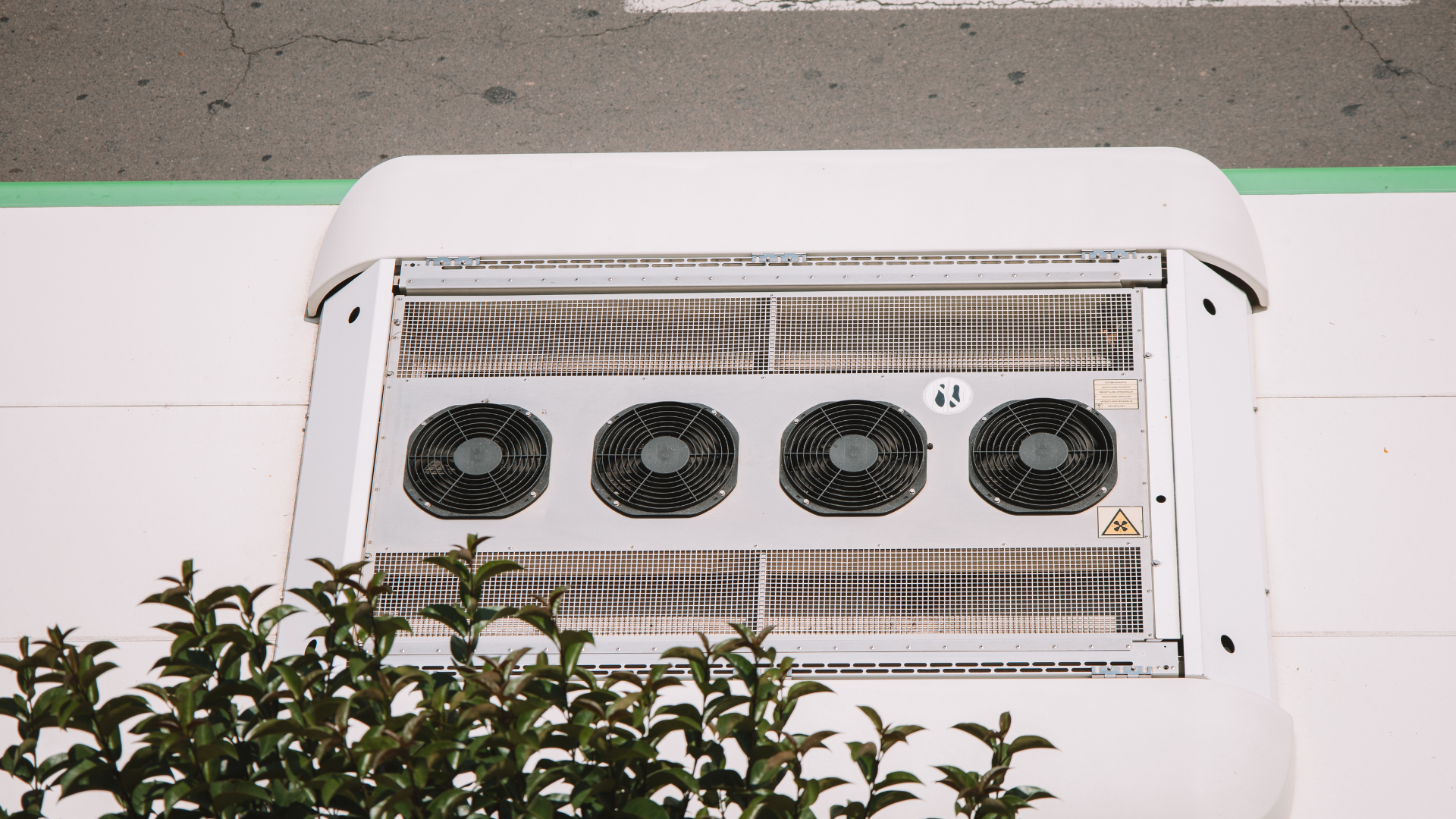Indoor Air Quality (IAQ) Services: Expanding Your HVAC Business
Every day, customers are reminded about the air they breathe, whether it’s an AQI alert on their phones, a news report on pollution, or a spike in seasonal allergies.
That awareness is changing what they expect from HVAC contractors. Indoor air quality (IAQ) products like UV lights, high-efficiency filters, and humidifiers are
becoming essentials. The catch? Many HVAC businesses still limit themselves to repairs and installations, leaving untapped revenue on the table.
Expanding into IAQ services doesn’t just solve a customer need; it positions your business for long-term growth in a market that’s only getting bigger.
Expanding Into the HVAC IAQ Market: How Contractors Can Boost Growth
In the sections ahead, we’ll look at how IAQ fits into the bigger HVAC picture, what products matter most, how to approach different customers, and where the global market is headed. Think of it as a roadmap for making IAQ a natural part of your business strategy.
Key Takeaways
- The HVAC IAQ market is expanding as awareness of air quality grows worldwide.
- Offering IAQ services helps contractors increase revenue and stand out from competitors.
- CRM tools make it easier to track IAQ deals, replacements, and recurring service opportunities.
- Global trends, like growth in the Asia Pacific and retrofits in aging infrastructure, are shaping demand.
Why the HVAC IAQ Market Is Heating Up
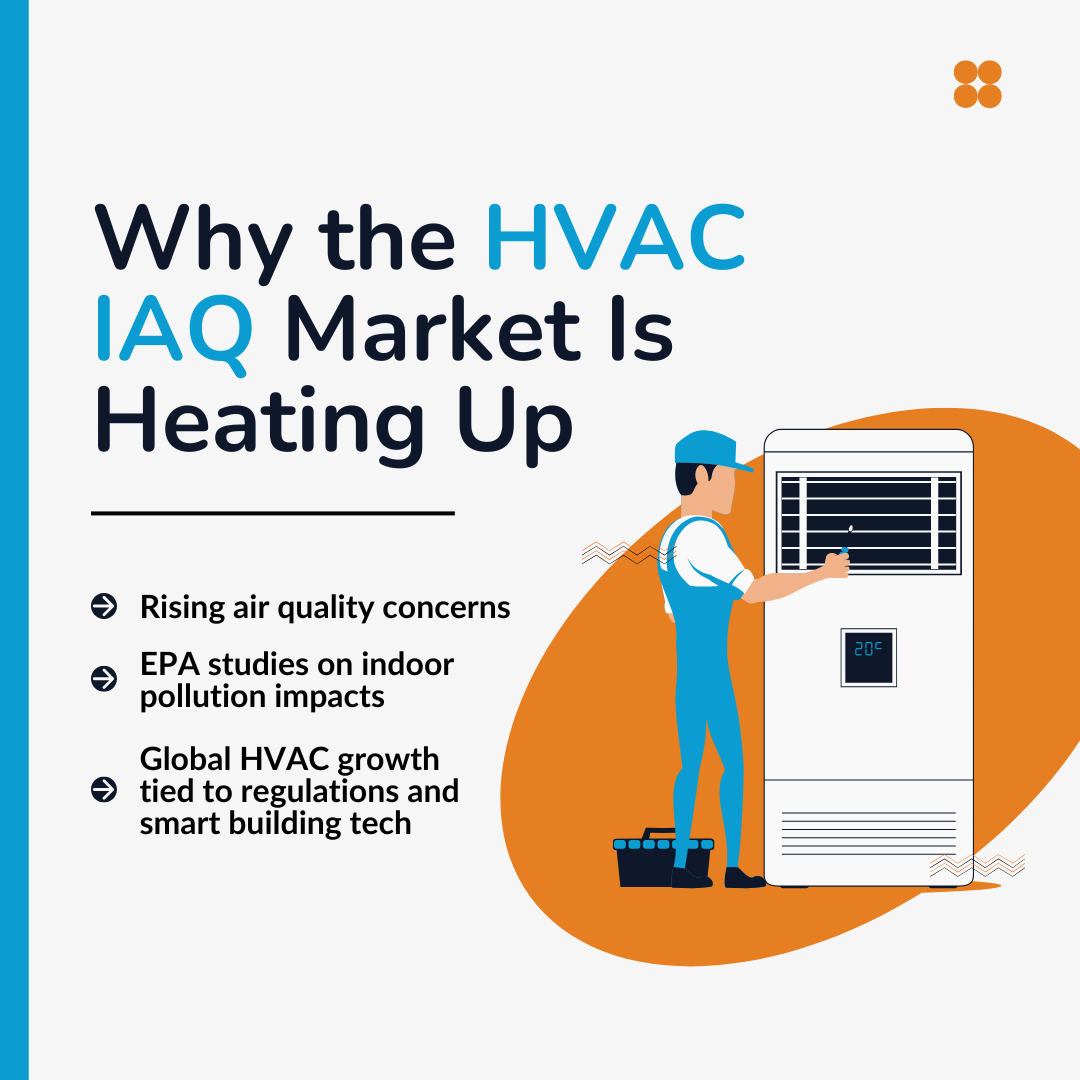
The HVAC IAQ market has expanded rapidly as concerns about air quality rise worldwide. From frequent AQI alerts to growing awareness of indoor air pollution, customers are looking for practical IAQ solutions that protect both comfort and human health.
The Environmental Protection Agency has linked poor indoor air to issues ranging from asthma to higher energy bills, making this a pressing need for households and commercial buildings alike.
At the same time, global HVAC growth is being shaped by stricter environmental regulations, new smart building technologies, and rising demand for energy-efficient HVAC systems.
For contractors, this means IAQ is no longer a side offering and is a core part of delivering value through modern HVAC systems and reducing operational costs for every end user.
Indoor Air Quality Services Every HVAC Contractor Should Offer
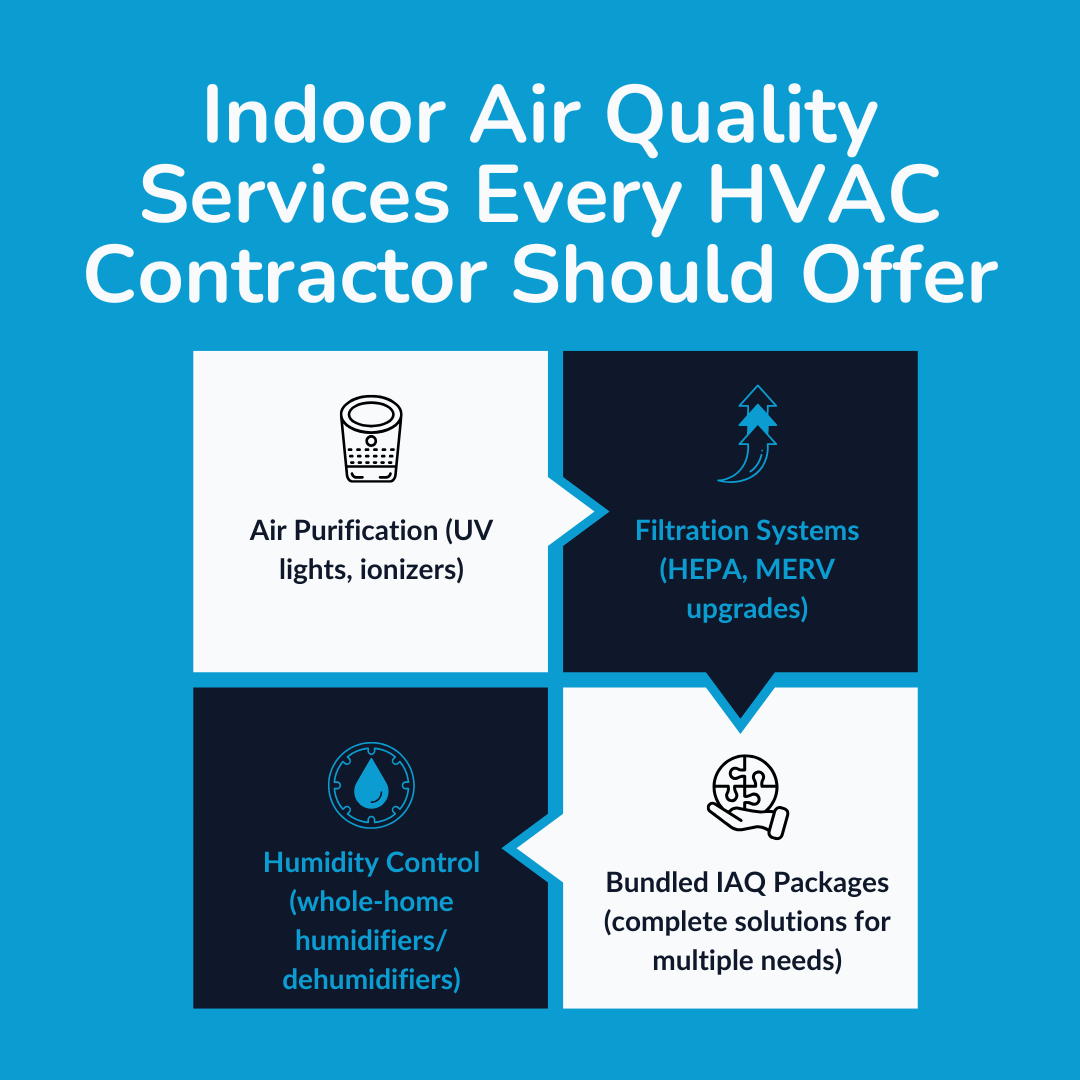
Expanding your service lineup with IAQ offerings allows you to solve customer problems while boosting your revenue. Below are the key categories to consider:
1. Air Purification
Air purification systems go beyond what standard temperature control provides. UV lights and ionizers help reduce contaminants like bacteria, mold spores, and allergens, creating a healthier indoor environment for families and businesses.
Real-world example: Several healthcare facilities now rely on UV air purification to minimize airborne pathogens, especially in high-traffic spaces. You can highlight these use cases when educating residential customers who want the same level of protection in their homes.
2. Filtration Systems
Filtration is one of the simplest but most effective entry points for IAQ expansion. Upgrading from standard filters to HEPA or high-MERV options significantly helps in capturing fine particles and allergens.
Real-world example: Schools and commercial buildings have adopted advanced filtration systems to protect students and employees, making this a relatable talking point for homeowners. You can also turn filter replacements into recurring service opportunities, ensuring consistent touchpoints with customers.
3. Humidity Control
Humidity management goes hand in hand with comfort and health. Whole-home humidifiers and dehumidifiers prevent issues like mold growth, warped wood, and dry indoor air that irritates skin and sinuses. Keeping humidity balanced helps protect both the home and the people living in it.
Real-world example: Museums often install whole-building humidifiers and dehumidifiers to protect artwork and archival materials. You can use these high-stakes scenarios to illustrate the everyday value of balanced humidity in homes, showing that it’s not just about comfort, but also about preservation and health.
4. Bundled IAQ Packages
Bundling IAQ services makes it easier for customers to see the value in a complete solution. Instead of choosing individual add-ons, they get a package that covers multiple needs, like pairing advanced filtration with UV purification and humidity control. This approach simplifies the decision, increases trust, and often leads to
higher-value sales.
Real-world example: Schools and facility managers in office spaces are increasingly choosing bundled IAQ solutions to meet health and safety standards.
Homeowners may not need systems at the same scale, but they appreciate the simplicity of an all-in-one package that keeps their indoor environment healthier and easier to maintain.
Selling IAQ Add-Ons in a Crowded HVAC IAQ Market
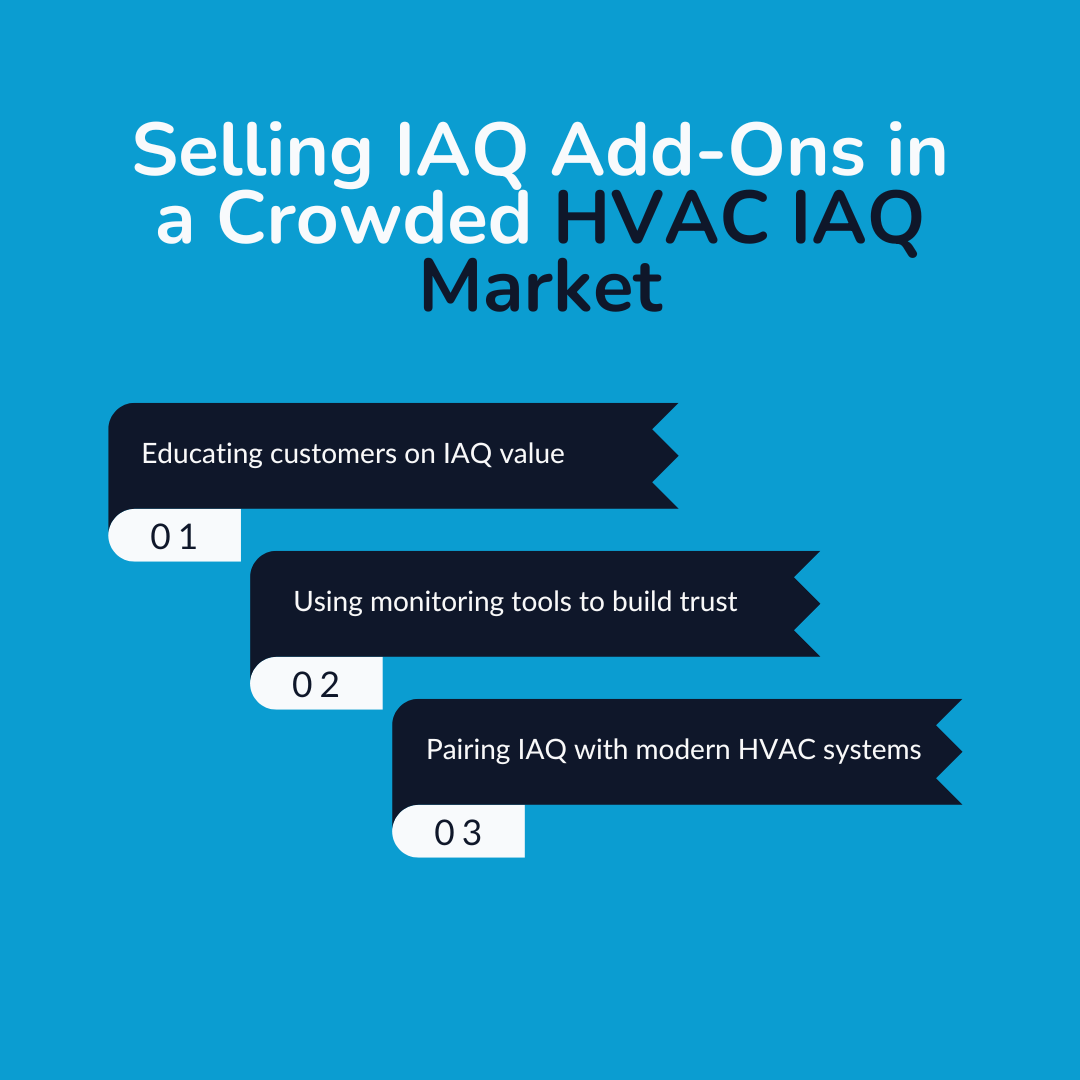
Selling IAQ products is more than just listing their features and selling a few add-ons. You also need to help your customers understand why the IAQ products matter.
Below, we have listed a few practical ways you can position IAQ add-ons, from educating customers to using monitoring tools and pairing products with modern systems.
1. Educating Customers
Most customers have heard of filters or purifiers, but don’t always know the difference between them. You can position yourself as a trusted guide, explaining how each product supports healthier indoor air quality solutions and ties into the bigger picture of comfort and energy efficiency.
2. Using Monitoring to Build Trust
One of the best ways to show value is through HVAC air quality monitoring. Measuring pollutants, humidity, and even volatile organic compounds gives you data you can share with customers.
It turns an abstract conversation into something they can see, helping them understand exactly how your recommendations improve their environment. In North
America, this data-driven approach is increasingly expected across the HVAC industry.
3. Pairing with Modern Systems
IAQ add-ons sell best when framed as part of a complete comfort package. Bundling products with advanced HVAC systems or air conditioning systems helps customers see them as essentials rather than extras.
This approach also directly ties to improving air quality, lowering health risks, reducing energy consumption, and aligning with Energy and Environmental Design standards.
Tracking IAQ Sales Through CRM
Expanding into IAQ services is one thing, and managing those sales is another. Without the right systems, it’s easy for leads to slip away or for follow-ups to be forgotten.
Below, we have discussed how CRM tools can help contractors manage IAQ sales more effectively, from tracking leads to creating long-term customer relationships.
> Why Contractors Miss Opportunities
Most HVAC businesses don’t have a clear process for managing IAQ sales. A technician may recommend a filter upgrade or a purifier during a visit, but if the customer doesn’t buy on the spot, that lead often gets lost.
Similarly, seasonal services like humidity control or recurring filter replacements are easy to forget without a system in place. This lack of organization is one of the main reasons contractors leave IAQ revenue untapped.
> How CRM Simplifies IAQ Tracking
A CRM creates visibility into every IAQ opportunity. Through this, Contractors can:
- Tag leads by product type (UV lights, filtration systems, humidifiers), making it easy to see which customers are interested in which solutions.
- Automate reminders for recurring needs like filter changes or annual purification maintenance.
- Track sales stages, so you know whether an IAQ lead is at the awareness, consideration, or decision stage.
- Segment customers by industry or property type, helping you target follow-ups differently for homeowners, offices, or healthcare facilities.
This not only keeps IAQ deals from slipping through the cracks but also gives you data to spot trends, like which products are most popular in certain neighborhoods or seasons.
> Creating Recurring Revenue
IAQ services naturally lend themselves to ongoing relationships. Filters wear out, humidity levels fluctuate, and purification systems require periodic servicing.
A CRM lets you schedule these touchpoints in advance, so you’re not waiting for the customer to remember.
They get a timely call or email from you. Over time, this turns one-off IAQ sales into steady, predictable income, while also boosting customer satisfaction because they feel looked after.
Check out: What is HVAC CRM Software and How Can It Grow Your Business?
Opportunities Across the Global HVAC IAQ Market
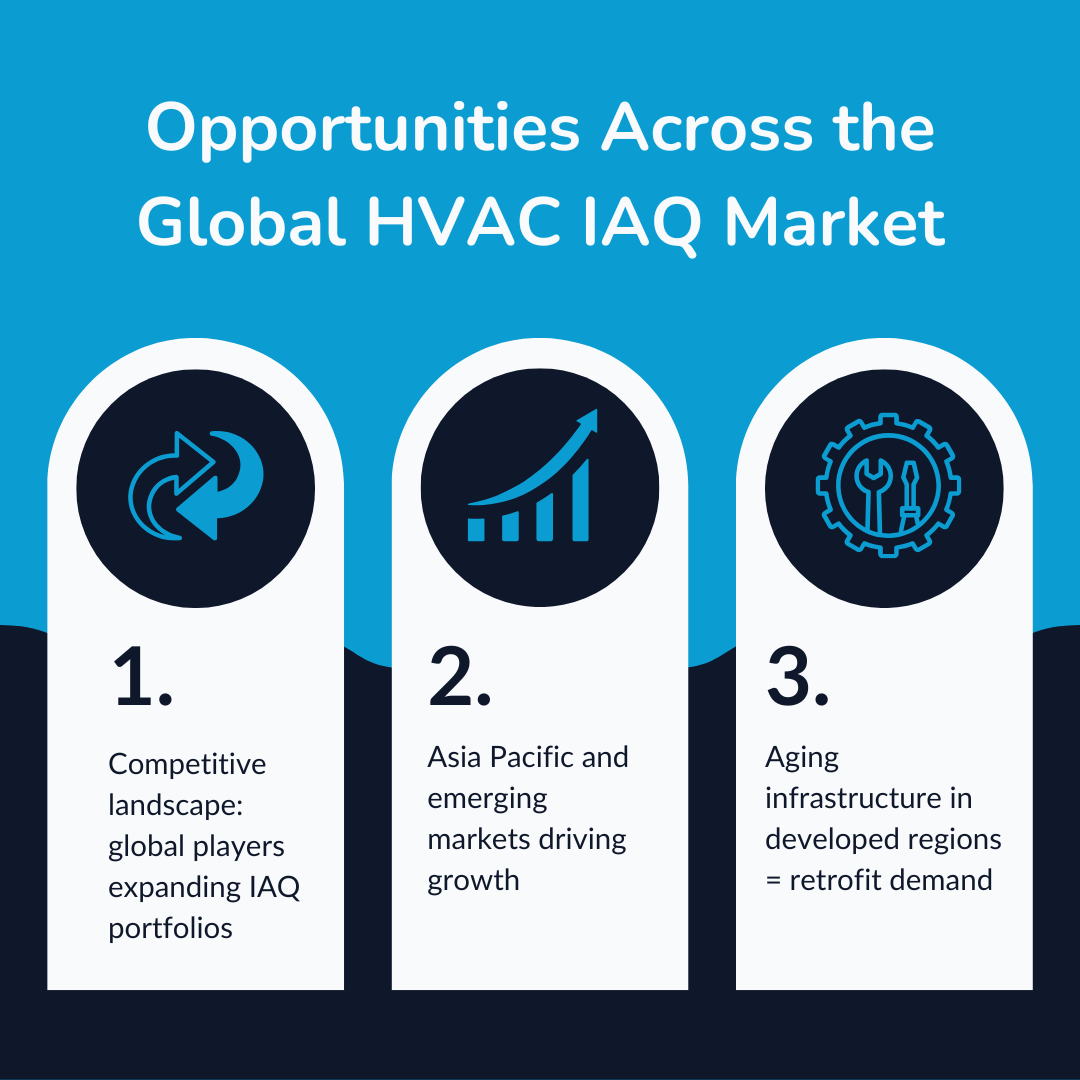
Below, we'll discuss where demand for IAQ is growing the fastest, from developing regions investing in clean-air solutions to developed markets upgrading aging infrastructure.
1. Competitive Landscape
The global HVAC market for IAQ is highly competitive, with major players operating across different regions. Companies like Carrier Global Corporation,
Honeywell International Inc. and Mitsubishi Electric Corporation are expanding their portfolios to include more IAQ-focused products.
For contractors, understanding this competitive landscape helps in positioning themselves as local experts who can deliver solutions on par with global leaders.
2. Asia Pacific and Emerging Markets
In the Asia Pacific, rapid urbanization and rising pollution levels are driving significant demand for IAQ services.
Many emerging markets in this region are also experiencing a rising demand for IAQ upgrades as middle-class homeowners invest in healthier environments.
Contractors who can offer accessible packages tailored to these markets will find strong opportunities.
3. Aging Infrastructure in Developed Regions
In contrast, North America and Europe are facing aging infrastructure, where retrofits and upgrades are the top priority.
Older buildings often lack adequate ventilation systems, making them prime candidates for IAQ add-ons like filtration and purification.
Moreover, building owners and facility managers in these regions are also under pressure to comply with stricter regulatory standards and stringent environmental regulations, which boosts demand for IAQ retrofits.
4. Commercial and Residential Demand
Both commercial and residential sectors are investing heavily in IAQ. Commercial buildings, from offices to schools, are under pressure to provide safe environments, while residential construction projects increasingly include IAQ solutions as part of the design phase.
This dual push creates consistent demand that contractors can tap into by tailoring their messaging to each end user.
Building Long-Term IAQ Revenue Streams
This is where we'll understand how contractors can turn IAQ services from one-time upgrades into recurring income that strengthens customer loyalty.
1. Service Contracts and Maintenance
IAQ products, like filters, purifiers, and humidifiers, require regular maintenance. By offering service contracts, you can lock in recurring visits while ensuring customers always enjoy optimal performance.
This approach helps with predictive maintenance, reducing surprise issues and keeping systems running efficiently.
2. Seasonal Campaigns
Air quality needs change throughout the year. Allergy season, wildfire smoke, or even high-humidity summers create natural opportunities for outreach.
With a proactive campaign calendar, you can align promotions with seasonal pain points, driving steady business while lowering operational costs for customers through timely upkeep.
3. Customer Education and Trust
Long-term revenue depends on trust. Contractors who take the time to explain the health and comfort benefits of IAQ upgrades and back them up with HVAC air quality monitoring results are more likely to win repeat business.
This not only builds stronger relationships but also improves operational efficiency by reducing callbacks and unscheduled visits.
Also read: HVAC Project Management 101: Tools, Tips, and Software
Future of IAQ in Commercial and Residential Sectors
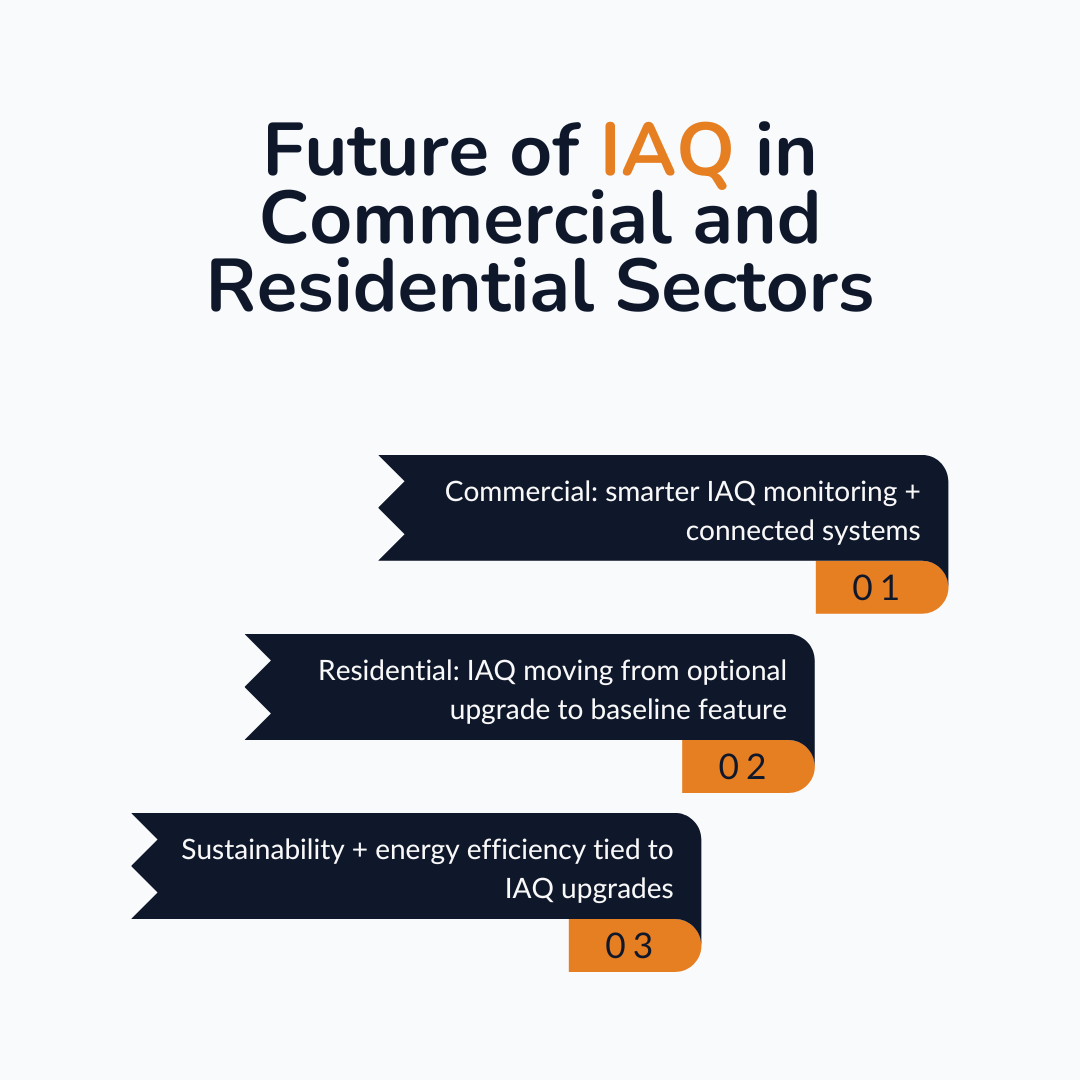
Technology, regulation, and customer expectations across both commercial and residential spaces are shaping the future of IAQ.
- In commercial buildings, demand is growing for smarter systems that integrate IAQ monitoring with connected controls. Schools, offices, and healthcare facilities are adopting these upgrades not only to protect occupants but also to meet stricter regulatory standards.
- On the residential side, IAQ is moving from an optional upgrade to a baseline feature. Many new residential construction projects are designed with IAQ in mind, incorporating better filtration, humidity control, and even real-time monitoring. Paired with smart technologies and smart building technologies, these systems allow homeowners to track their indoor air and make adjustments instantly.
The push for healthier spaces also ties into sustainability. Contractors who can combine IAQ offerings with energy-efficient HVAC systems and other eco-focused solutions will be well-positioned to meet the twin goals of occupant health and energy usage reduction.
For the HVAC sector, this means IAQ will no longer be treated as a side business. It will be a defining part of the next generation of HVAC solutions.
How to Position Your HVAC Business in the Competitive Landscape

Below, we discuss how contractors can stand out in a market where global brands and local competitors are all vying for attention.
1. Differentiate With Expertise
Homeowners and businesses want more than installations. They want guidance, and positioning yourself as an IAQ expert means offering education, personalized recommendations, and proof through HVAC air quality monitoring. This sets you apart from contractors who only sell equipment.
2. Leverage Certifications and Standards
Credibility matters in a crowded market, so pursuing certifications tied to IAQ or energy and environmental design gives you an edge, especially with building owners and facility managers making purchasing decisions for commercial construction or retrofit projects.
3. Highlight Case Applications
Sharing how IAQ upgrades work in the real world helps customers connect the dots. Examples might include healthcare facilities that reduced contaminants with advanced purification, or commercial demand in office retrofits where better IAQ helped retain tenants. Stories like these demonstrate both technical skill and practical results.
4. Align With Major Players
While you can’t compete head-to-head with giants like Honeywell International, Carrier Global Corporation, or Trane Technologies plc, you can align your services with the standards they set.
Position your business as delivering the same quality on a local scale, with the added benefit of personalized service and faster response times.
How HVACBase Helps You Win in the HVAC IAQ Market
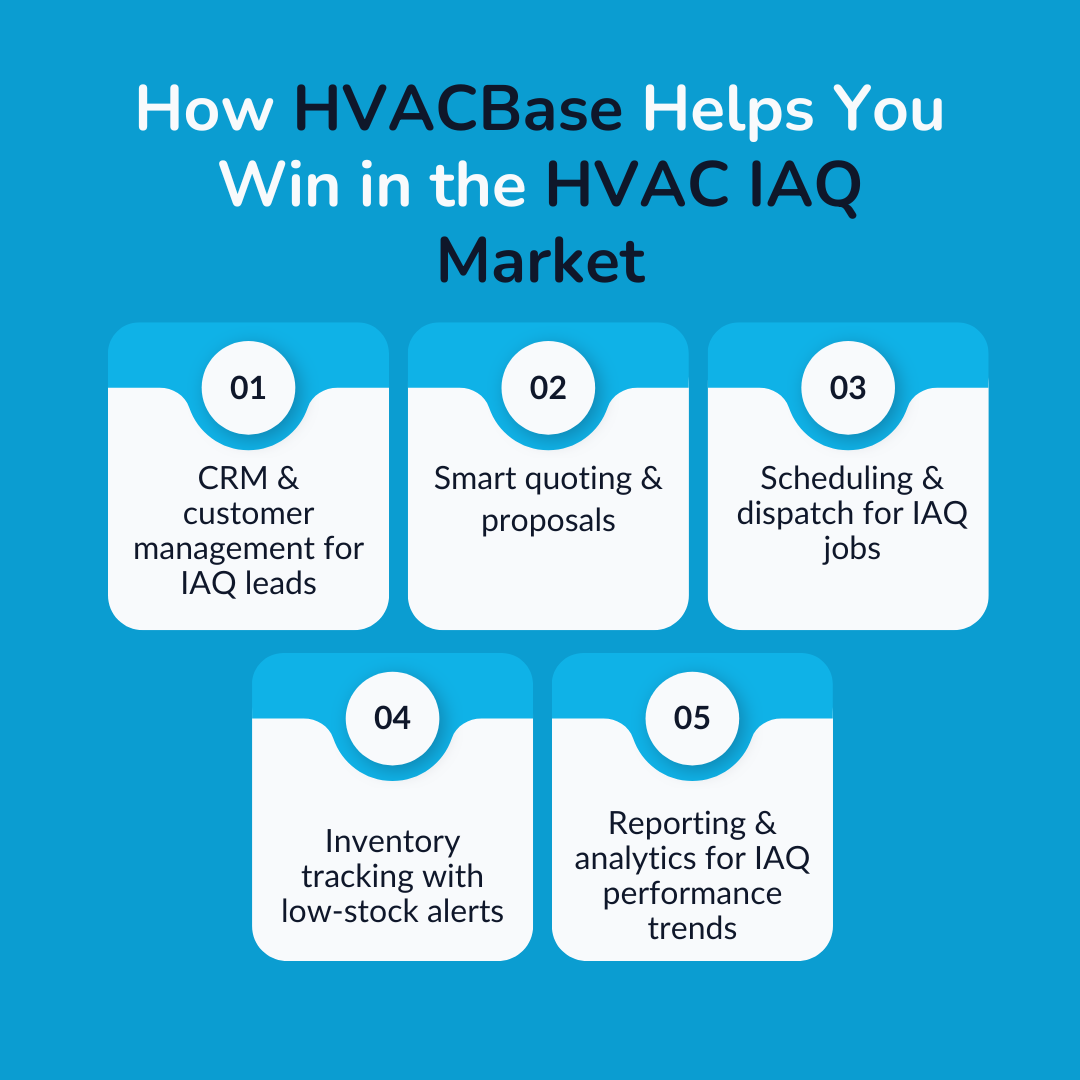
CRM & Customer Management:
All your leads and customer interactions are stored in one system, so you never lose track of IAQ prospects. Whether a technician suggests a filter upgrade or a customer inquires about purification, the CRM keeps everything organized and easy to follow up on.
Smart Quoting & Proposals:
HVACBase’s proposal tools let you create professional, branded quotes with clear pricing and product details. This helps you present IAQ upgrades, like filtration or humidity control, in a polished way that builds trust and makes closing deals easier.
Scheduling & Dispatch:
With built-in scheduling and dispatch, IAQ jobs flow seamlessly alongside your regular HVAC services. You can assign the right tech, optimize routes, and keep the customer updated in real time, all from the same platform.
Mobile Field Tools:
Technicians can access job details, update statuses, collect signatures, and even upload photos directly from the field. This keeps IAQ work transparent and ensures customers feel informed every step of the way.
Inventory Tracking:
IAQ add-ons rely on having the right parts ready, including filters, lamps, and more. HVACBase’s inventory management gives you real-time stock levels and alerts when items are running low, so you’re never caught unprepared.
Design & Load Calculation:
HVACBase’s design and load calculation software ensures every HVAC system is sized with precision. It automatically performs ACCA-compliant Manual J calculations based on real building data like insulation, windows, and climate, so you can recommend the right system without guesswork.
Check out: How Commercial HVAC Service Software Streamlines Fieldwork
Conclusion
Indoor air quality is central to how the HVAC industry is evolving. Contractors who expand into IAQ offerings can boost revenue, strengthen customer relationships, and stay competitive in a market that’s demanding healthier spaces.
From purification and filtration to humidity control and monitoring, the opportunity is wide open. The key is pairing the right services with the right tools to track, manage, and grow them.
Take Control of the HVAC IAQ Market
HVACBase gives you the platform needed to turn IAQ services into long-term growth. From quoting and scheduling to inventory and analytics, every feature is built to keep IAQ jobs organized and profitable.
Don’t leave revenue on the table. Equip your business with the tools to close more IAQ deals and stay ahead in a competitive market. Book your demo today.
FAQs
1. Why should HVAC contractors expand into IAQ services?
Because customers now expect healthier indoor environments, IAQ products have shifted from add-ons to essentials. Expanding into IAQ allows contractors to boost average ticket size, secure recurring revenue, and stand out from competitors.
2. What types of IAQ products are most in demand?
Filters, UV purification systems, and humidity control equipment are popular among homeowners and businesses. These address common concerns, such as allergens, mold, and comfort, making them easy to market and bundle with regular HVAC services.
3. How does a CRM like HVACBase help with IAQ sales?
A CRM keeps IAQ leads, quotes, and service schedules organized in one place. It ensures no opportunity is missed, automates follow-ups for recurring services, and provides analytics to refine your sales strategy over time.
Have questions or need personalized advice?
Talk to an Expert Today and let our construction specialists guide you to success.



